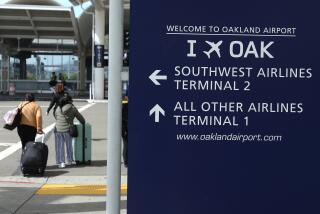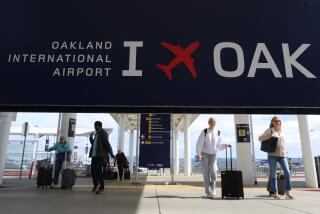Flybys hit too close to home in Hermosa Beach

Bob Dobry’s little plane putt-putted over the coast. Below, three sea kayakers whirled their paddles in figure-eights; from the cockpit, they looked like water bugs scurrying across a pond. It was going to be a sunny day, and Hermosa Beach was already filling up.
Incoming.
“Scout 625 Alpha Papa,” Dobry said into his radio, using his tail number. “We’d like to work the shoreline.”
“Six two five Alpha Papa,” the control tower replied. “You’ll be at 1,100 feet?”
“Negative,” Dobry said. “We’ll be at 500.”
Dobry, 53, dipped his plane with the deft touch of a man who has logged 11,000 hours in a cockpit. Suddenly, it all came into relief -- the lettering on the dive bars lining the Strand, the beach towels drying on hotel balconies, the masts of the boats at King Harbor. Dobry was so close he could no longer be ignored, which was precisely the point -- and the problem.
For half a century, planes like this one have been towing banner advertisements over the beach. But this summer, some residents and business owners, particularly in the South Bay, have decided that enough is enough.
They have declared war on the half-dozen companies that fly most of the planes. Dobry, a stout man with a crew cut, owns Aerial Promotions Inc., the largest ad-towing company in Southern California. From his point of view, his critics have declared war on commerce itself.
This weekend, thousands of people are expected at South Bay beaches for the International Surf Festival. Each will be an unwitting guinea pig in an experiment that will help determine whether the two sides of the aerial ad debate can achieve a fragile peace without landing in court.
The surf festival will be one of the first tests of a “code of conduct” asking the pilots to follow rules that are stricter than those of the Federal Aviation Administration, which restrict planes’ minimum altitude -- 1,000 feet over inland areas, generally, and 500 feet over the ocean.
Under the new code, for instance, pilots wouldn’t make more than four passes over a section of shore in a 20-minute block, would use mufflers when possible and would fly at least 1,200 feet high if circling an event.
The agreement carries the tone of a cease-fire; it is surely one of the first official documents to quote the words of essayist and poet Ralph Waldo Emerson. It’s right there on Page 2: “Each man takes care that his neighbor shall not cheat him. But a day comes when he begins to care that he does not cheat his neighbor. Then all goes well; he has changed his market-cart into a chariot of the sun.”
This skirmish, however, might not simply dissolve in the musings of a transcendentalist. That’s because, at its heart, it is about more than a few planes towing ads for beers and Toyotas and fish tacos.
Anyone who has spent time in the South Bay in recent years knows it has changed.
Peter Tucker, 61, a Hermosa Beach councilman, remembers when Hawthorne Boulevard was a two-lane road lined with bean fields and strawberry farms. Today, the land alone at one South Bay house under construction costs $12 million, Tucker said. Rent for retail space can be as high as $8 per square foot; the stores -- and prices -- reflect it. Even among those who still love the place, there is a sense that some pockets have become little more than a commercial enterprise.
“We’re still laid-back, still not too sophisticated,” said Tucker, a leader of the effort to negotiate a compromise over the ads. “But it has changed.”
The debate over the ads is viewed through that prism of change.
To Dobry, the planes are, by now, “part of going to the beach.”
“It’s no different than a couple of kids playing with a ball or somebody surfing or laying there getting a suntan,” he said. “It’s just part of the environment.”
That’s not logic that Dave Hollander, chief executive of Becker Surfboards, can follow.
“Just because we’re used to them they should stay? That’s not right,” said Hollander, 55, who lives in Hermosa Beach, where Becker’s main store is located.
For many, the tipping point came at a beach volleyball tournament last summer, when the planes seemed as prevalent -- and as close, in some cases -- as mosquitoes. Around the same time, Hollander started posting ads in local newspapers urging a boycott of companies that advertised on the planes.
“We’ve just had it. Considering the impact on our greatest natural resource . . . it’s pure beach pollution,” he said. “They are noisy. They are ugly. They are awful.”
They are also legal, with limitations. But even that is no simple issue.
The planes, which typically tow signs that are 35 feet tall and 100 feet long at speeds as slow as 40 mph, are regulated by the FAA. But several local governments have tried to take control.
Huntington Beach banned the flights, then backed off in 2002 after an anti-abortion group sued, claiming a 1st Amendment violation.
Honolulu’s ban was upheld in 2006 by a federal court, which held that the city’s rules could not be preempted by the Feds.
While that case was being appealed, however, the FAA further muddied the waters by tinkering with its own rules -- adding language that simultaneously reasserted control over the airspace while reminding pilots to pay attention to local rules.
Now no one knows what to do.
Mike Jenkins, who has contracted to be Hermosa Beach’s city attorney and whose firm also represents Malibu and El Segundo, said the Honolulu case was a “favorable precedent for having the ability under our police powers to ban aerial advertising outright.”
But the FAA says Honolulu’s rule still has no teeth. “They can ban flying,” said agency spokesman Mike Fergus, “but there is no jurisdictional authority.”
A regionwide ban in Southern California, meanwhile, would involve a host of municipalities and county governments -- and would almost certainly land in court.
Still, Hollander says there should be “no compromise.” And Dobry points out that he’s under no legal obligation to “appease the crybabies.”
“We follow the rules and regulations. We’re safe,” he said. “We’re here to stay.”
That’s why, for now, the code of conduct is the best anyone can come up with. This weekend, officials in Hermosa Beach and Manhattan Beach -- the two cities that have been most active in trying to negotiate peace -- will have their eyes on the sky.
“We’re making strides,” said Manhattan Beach Mayor Richard Montgomery. “But by no means is this over.”
More to Read
Start your day right
Sign up for Essential California for news, features and recommendations from the L.A. Times and beyond in your inbox six days a week.
You may occasionally receive promotional content from the Los Angeles Times.







